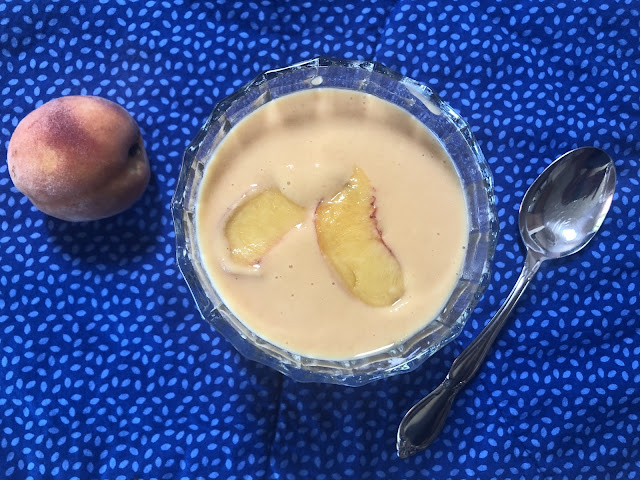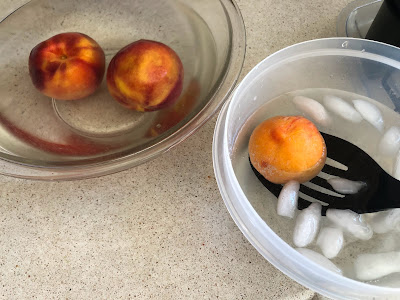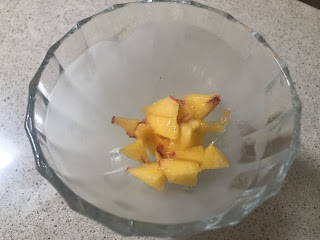
Recipe: Use very ripe fruit in this dish for best flavor

Garnish the soup with a few thin slices of peach before serving. (Photos: Kathy Morrison)
|
I dearly love peaches, and have long wanted to make the chilled peach soup recipe in "The Perfect Peach," published in 2013 by the peach-farming Masumoto family.
The cookbook is full of sweet and savory dishes as well as stories by David Mas Masumoto, whose family has grown heirloom peaches in the San Joaquin Valley for generations. (He gained national acclaim for the memoir "Epitaph for a Peach" in 1995, and has written other books since.)
Marcy Masumoto, his wife, developed this particular recipe. Interestingly, I found her version too creamy and not "peachy" enough. So the recipe below reflects my changes. The carrot puree may seem an odd inclusion, but it does give the soup some depth, and contributes to the lovely color.
I found some beautiful ripe peaches at our local fruit stand, but also included one of my six precious Honey Babe peaches, the total harvest from my miniature backyard peach tree. The peach nectar in the recipe is found in soda-like aluminum cans, usually in a store's juice section.

A hot water bath followed by a plunge into ice will
loosen the skins on peaches. The method works on
tomatoes, too. |
Chilled peach soup
Serves 4 to 6 as appetizer or brunch dish
Ingredients:
1 medium carrot, peeled and sliced or diced, about 1/2 cup
2 to 3 very ripe peaches (the Masumotos call them "gushers")
1/2 teaspoon grated fresh ginger root
1 teaspoon freshly squeezed lime juice
1/2 cup plain low-fat Greek yogurt
6 tablespoons canned peach nectar, divided
2 tablespoons half-and-half
Kosher salt
For garnish:
2 fresh peaches, one peeled and diced, the other thinly sliced, peeling optional (depends on how fuzzy it is)
Instructions:
Place the carrot pieces in a small saucepan and cover with about 1 cup cold water. Bring to a boil and then simmer on medium heat 5 to 7 minutes, until a knife point can easily pierce a carrot piece. Set the pan aside for the carrots to cool; do not drain.
Peel the 2 to 3 "gusher" peaches by cutting an X into the pointed end and dropping them into a bowl of hot water for a few minutes. Using a slotted spoon, transfer them to a bowl of ice water for a minute, then peel.
Slice the peeled peaches into the container of a blender. Blend on medium high until they are fully pureed. Pour out into a liquid measuring cup. You should have at least 1 cup of puree.
Don't clean the blender yet: Place the cooked carrots and 1/2 cup of their cooking liquid in the blender container and puree it. Pour in the peach puree, pulse to blend, then add the grated ginger, the lime juice, yogurt, 4 tablespoons of the peach nectar, and the half-and-half.

Fresh peach pieces go into the bowl before the
soup is poured over them.
|
Pour into a bowl or other large glass container, cover tightly, and chill at least 1 hour or overnight.
Before serving, add about 1/4 teaspoon kosher salt, then taste the soup. Adjust the taste and consistency by using more peach nectar, more salt or more lime juice, as preferred.
To serve, place a generous 1 tablespoon of the diced garnish peach in the bottom of a chilled bowl or ice cream dish. Pour about 1/2 cup of soup over the diced peaches, then garnish with 2 thin slices of the other garnish peach.
Comments
0 comments have been posted.Sacramento Digs Gardening to your inbox.
Food in My Back Yard Series
April 1: Don't be fooled by these garden myths
March 25: Fertilizer tips: How to 'feed' your vegetables for healthy growth
March 18: Time to give vegetable seedlings some more space
March 11: Ways to win the fight against weeds
March 4: Potatoes from the garden
Feb. 25: Plant a fruit tree now -- for later
Feb. 18: How to squeeze more food into less space
Feb. 11: When to plant? Consider staggering your transplants
Feb. 4: Starting in seed starting
Sites We Like
Garden Checklist for week of March 30
Your garden doesn’t mind April showers. Get busy now to enjoy those future flowers.
* Get ready to swing into action in the vegetable garden. As nights warm up over 50 degrees, start setting out tomato, pepper and eggplant transplants.
* From seed, plant beans, beets, cantaloupes, carrots, corn, cucumbers, melons, pumpkins, radishes and squash. (Soak beet seeds overnight in water for better germination,)
* Plant onion sets.
* In the flower garden, plant seeds for asters, cosmos, celosia, marigolds, salvia, sunflowers and zinnias.
* Transplant petunias, zinnias, geraniums and other summer bloomers.
* Plant perennials and dahlia tubers for summer bloom.
* Transplant lettuce and cabbage seedlings.
* April is the last chance to plant citrus trees such as dwarf orange, lemon and kumquat. These trees also look good in landscaping and provide fresh fruit in winter.
* Smell orange blossoms? Feed citrus trees with a low dose of balanced fertilizer (such as 10-10-10) during bloom to help set fruit. Keep an eye out for ants.
* Apply slow-release fertilizer to the lawn.